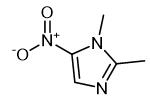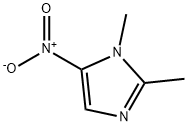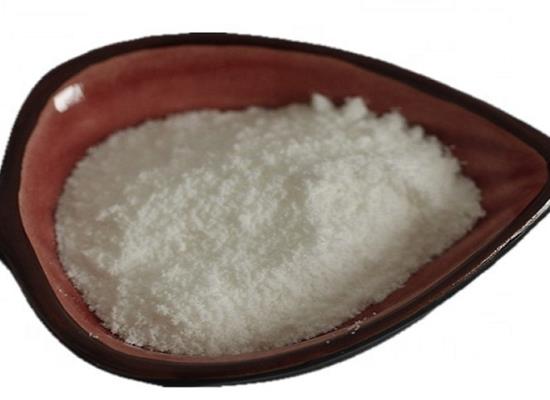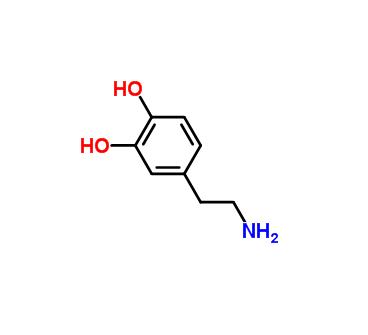Synthesis and Application of 1,2-Dimethyl-5-nitroimidazole
General description
1,2-Dimethyl-5-nitroimidazole, also known as dimetridazole, mainly used as veterinary antibiotics, is the first choice for prevention and treatment of swine diarrhea, but also can be used as feed additives, conducive to promoting the growth of livestock and poultry, a small amount of daily chemical industry. It is a growth promoting agent for livestock and poultry and a high efficiency, low toxicity and broad - spectrum antigenic insecticide. It can be used for pig feed, dosage of 50-100 g/t; It can also be used for chicken feed, dosage 125-200 g/t.

Fig. 1 The structure of 1,2-Dimethyl-5-nitroimidazole.
Physicochemical property
1,2-Dimethyl-5-nitroimidazole is a light yellow needle-like crystalline powder, tasteless, and its melting point is 138-139℃. It is soluble in chloroform, ethanol, dilute alkali and dilute acid, insoluble in hydrated ether. Its hydrochloride is soluble in hydrated ethanol and slightly soluble in acetone.
Preparation
1. Dissolve 40 g of urea in 100 mL of water, and add 40 mL of concentrated nitric acid to obtain solution I. Controlling the temperature to be less than 50 °C, slowly adding 70 g of 2-methylimidazole to 200 mL of industrial sulfuric acid to obtain solution II. The solution II was slowly poured into the solution I, placed at room temperature for 24 hours, then heated to 80 °C with stirring for 2 hours, and heated to 110 °C for 0.5 hours. After cooling to 80°C, 200 mL of concentrated nitric acid was added dropwise, the temperature was raised to 120°C, and the reaction was stirred for 2 h. Finally, the excess nitric acid was evaporated below 150°C. Cool to 40℃, dilute with 400 mL water, adjust pH=3.5-4.0 with ammonia water. It was cooled to room temperature, filtered, washed with water and dried to obtain 83.8 g of 2-methyl-5-nitroimidazole (melting point 248-250°C) with a yield of 77.3%.
2. Add 50 g of the above product and 60 mL of 85% formic acid to the three-necked flask, heat to 80 °C, dropwise add 60 g of dimethyl sulfate [(CH3)2SO4] within 30 min, and then react for 0.5 h. Then the solvent was evaporated, 50 mL of water was added, the residual acid was distilled, 50 mL of water was added, and the pH value of ammonia water was adjusted to 2.5. Cool to room temperature, filter, and dry the filter residue to obtain 12.4 g of unreacted 2-methyl-5-nitroimidazole. After the filtrate was decolorized with activated carbon, ammonia water was added to adjust pH=6-7, filtered, washed and dried to obtain 29.3 g of the product (melting point 138-140°C) with a yield of 70.3%. The overall yield was 54.3%.
Application
Bioactivity
1. The anti-trichomonal efficacy and pharmacokinetics of dimetridazole were investigated in the homing pigeon (Columba livia). Dimetridazole was formulated for drinking water medication and as a prolonged-release tablet, To suppress a Trichomonas gallinae infection successfully, medicated drinking water containing dimetridazole (400 mg/L) had to be administered for at least 3 days, A two-day treatment with a dimetridazole tablet (20 mg/tablet) in fasted, as well as in fed, pigeons was shown to be ineffective, After intravenous administration of 20 mg dimetridazole, the drug plasma concentration-time profile fitted a one-compartment open model with a mean half-life of 3.9 h. The absolute bioavailability of the tablet in fasted pigeons was 83.8%, The bioavailability of the tablet administered with food was reduced by 20%, Dimetridazole was rapidly metabolised to (1-methyl-5-nitroimidazol-2-yl)methanol [1].
2. The in vivo tolerance and in vivo and in vitro efficacy of 1,2 dimethyl 1-5-nitroimidazole (dimetridazole) against pharyngeal trichomoniasis in pigeons was studied. Dimetridazole was well tolerated at the doses given and no side effects were observed. Pigeons naturally infected with trichomonads were treated individually with dimetridazole capsules for five days. No trichomonads were detected during the one month period of observation. Following a single dose of dimetridazole the pigeons were positive for trichomonads after fourteen days. Four trichomonas isolates were tested for in vitro efficacy with various concentrations of dimetridazole in chicken embryo fibroblast (CEF) cultures. Complete inhibition was achieved by the addition of 7.5 mg, or more, dimetridazole to the cultures. Quantitative herpesvirus isolations were carried out on swabs with trichomonads after sedimentation, centrifugation and sonification. The results indicated that trichomonads may act as a staple host and vector for pigeon herpes virus [2].
Detection method
1. A three-dimensional Cu2O/electrochemically reduced graphene (ErGO)-modified electrode was developed for the determination of dimetridazole. Cu2O/GO was initially prepared using a modified solvothermal method, and the 3D structure was constructed by electrodepositing a Cu2O/GO dispersion on a glassy carbon electrode in the presence of lithium perchlorate. The enhanced electrocatalytic reduction of dimetridazole was confirmed, and the electrochemical reduction reaction was found to be a typical adsorption-controlled process. Our results revealed that the response to dimetridazole was linear in the concentration range of 30-150 nmol L-1 and the detection limit was 3.64 nmol L-1. The prepared electrode was also employed to detect dimetridazole in an egg sample, thereby indicating its potential practical application [3].
2. In this experiment, a highly effective electrochemical sensor based on a molecularly imprinted polymer has been developed for ultrasensitive detection of dimetridazole. The sensor was made by incorporating of dimetridazole as a template molecule during the electropolymerization of poly-arginine on a glassy carbon electrode. The modified electrode GCE/P-Arg@MIP was characterized by voltammetric and microscopic techniques. Differential pulse voltammetry method was used to detect target analyte under the optimum condition. The DPV response to dimetridazole was linear at 0.1 x 10-9 to 10 x 10-6 mol L-1 (R2 = 0.996), with a method detection limit (S/N = 3) of 0.1 x 10-9 mol L-1. Moreover, the proposed sensor shows satisfactory recovery ranges for the determination dimetridazole in commercially available egg, milk and honey samples [4].
References
[1] Inghelbrecht S, Vermeersch H, Ronsmans S, et al. Pharmacokinetics and anti‐trichomonal efficacy of a dimetridazole tablet and water‐soluble powder in homing pigeons (Columb a livia)[J]. Journal of veterinary pharmacology and therapeutics, 1996, 19(1): 62-67.
[2] Gravendyck M, Schroeder-Gravendyck S. Tolerance and efficacy of oral administration of dimetridazole for the treatment of pharyngeal trichomoniasis of pigeons[J]. Tieraerztliche Umschau, 1997, 52(3): 134-143.
[3] Ma X, Li J, Luo J, et al. Electrochemical sensor for the determination of dimetridazole using a 3D Cu 2 O/ErGO-modified electrode[J]. Analytical Methods, 2018, 10(27): 3380-3385.
[4] Ali M R, Bacchu M S, Daizy M, et al. A highly sensitive poly-arginine based MIP as an electrochemical sensor for selective detection of dimetridazole[J]. Analytica Chimica Acta, 2020, 1121: 11-16.
Related articles And Qustion
Lastest Price from 1,2-Dimethyl-5-nitroimidazole manufacturers

US $0.00/kg2025-05-20
- CAS:
- 551-92-8
- Min. Order:
- 25kg
- Purity:
- 98%min; BPV2013
- Supply Ability:
- 80tons/month

US $10.00/KG2025-04-21
- CAS:
- 551-92-8
- Min. Order:
- 100KG
- Purity:
- 99%
- Supply Ability:
- 100 mt


